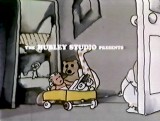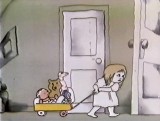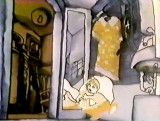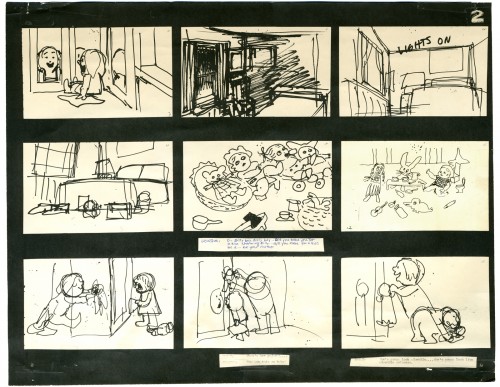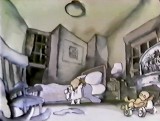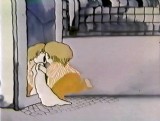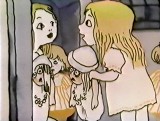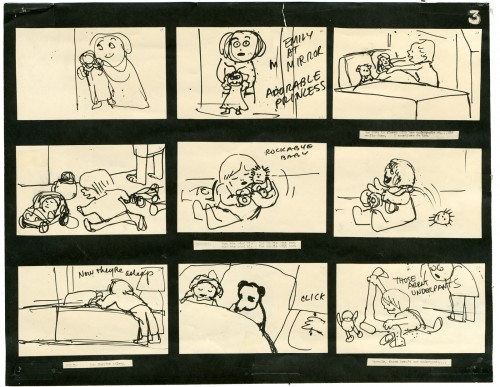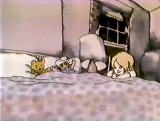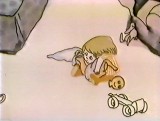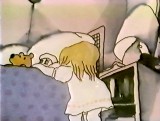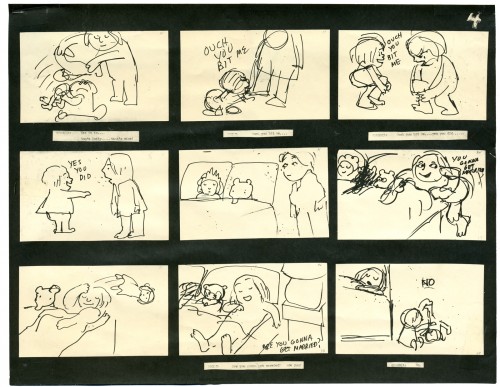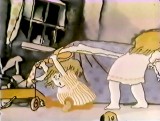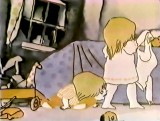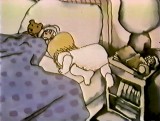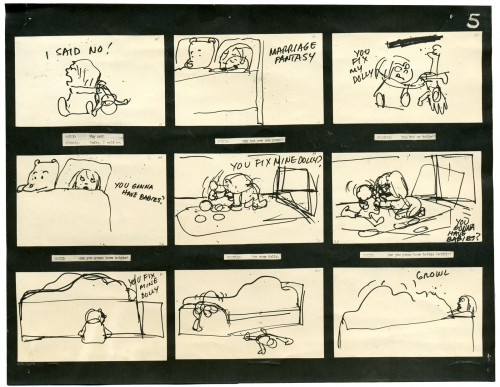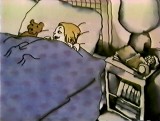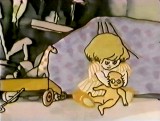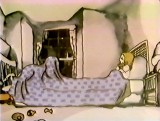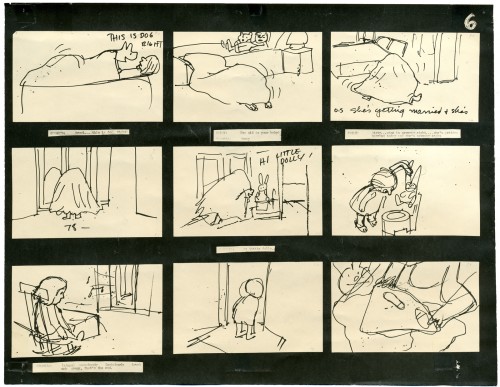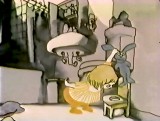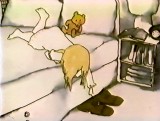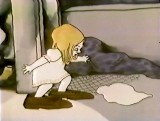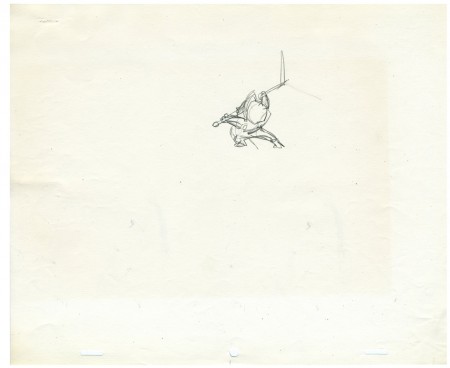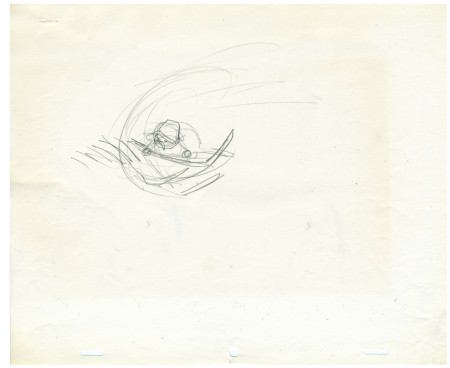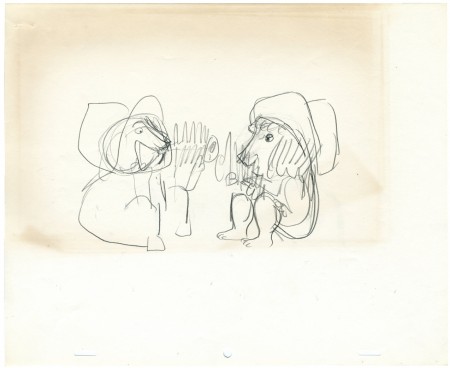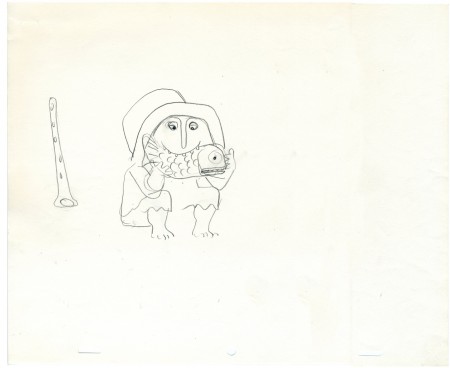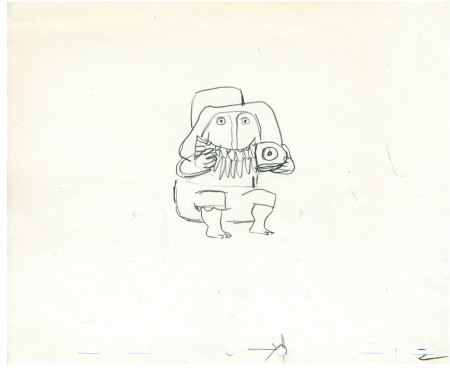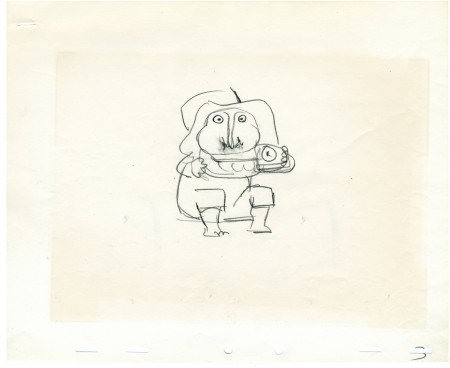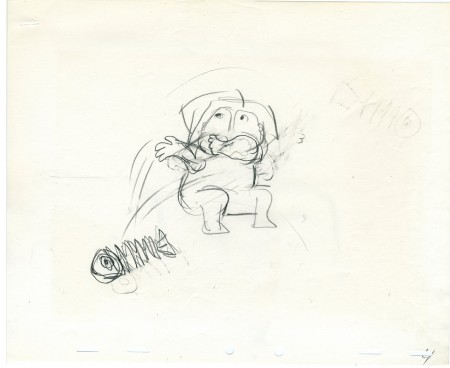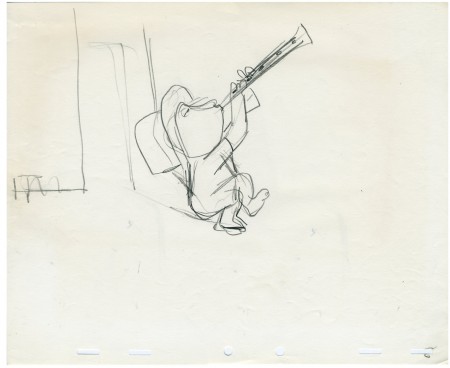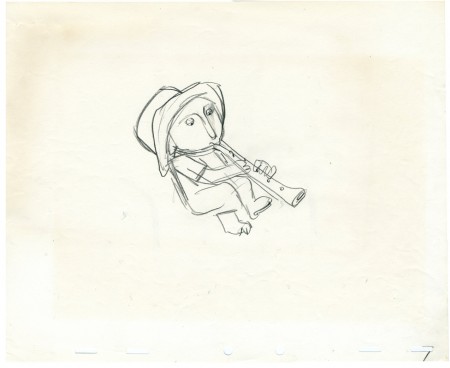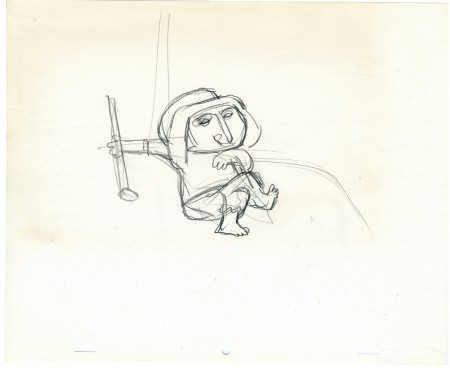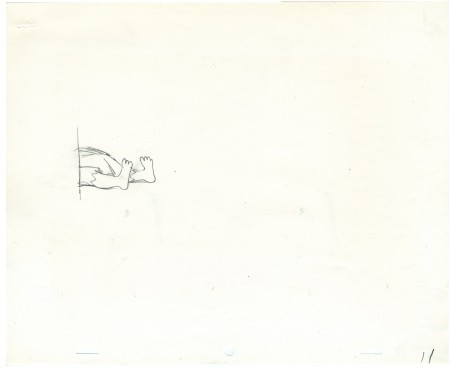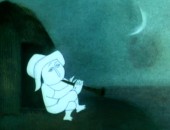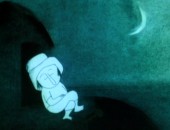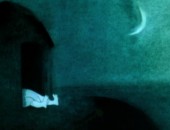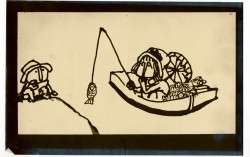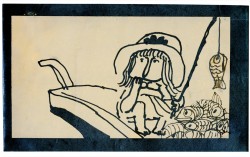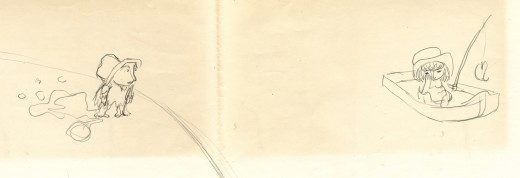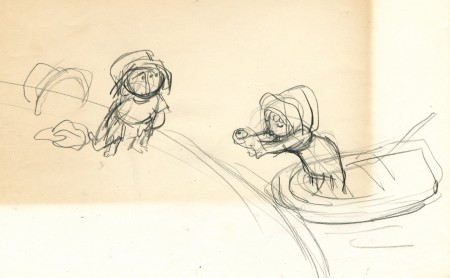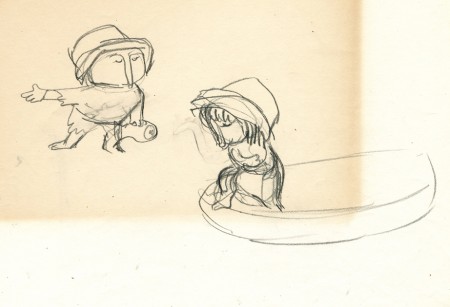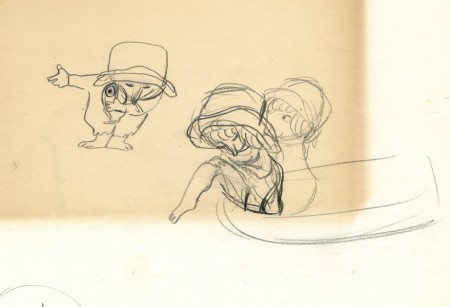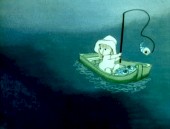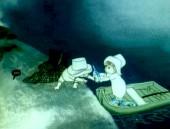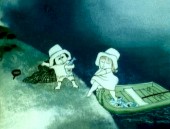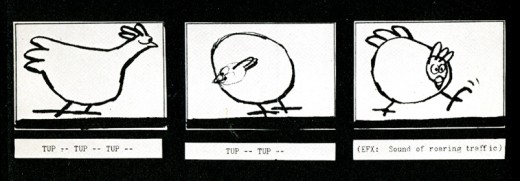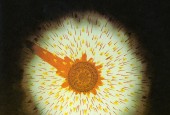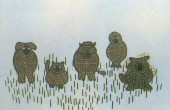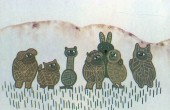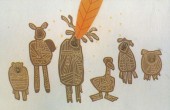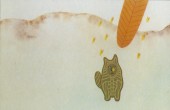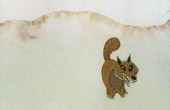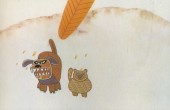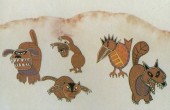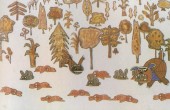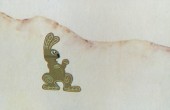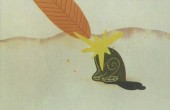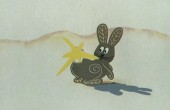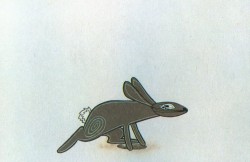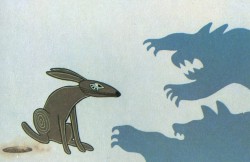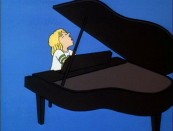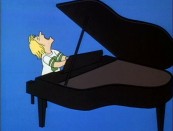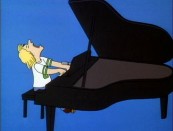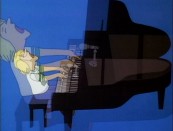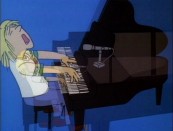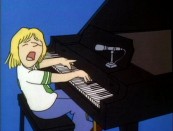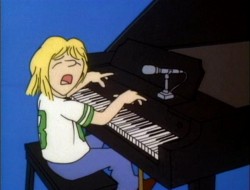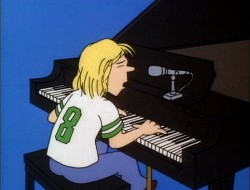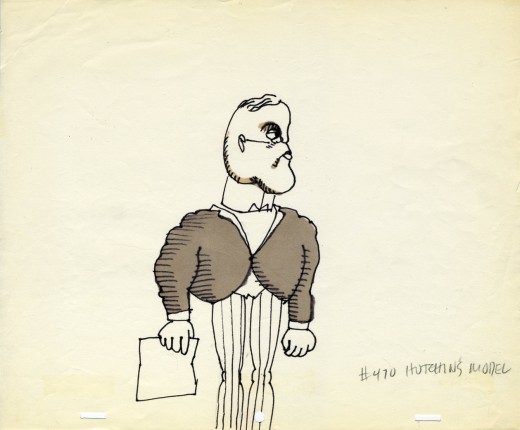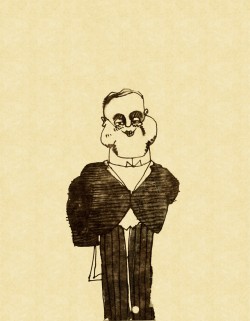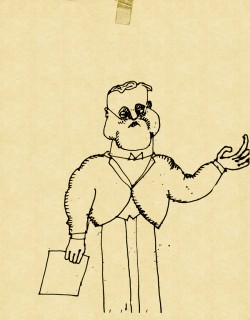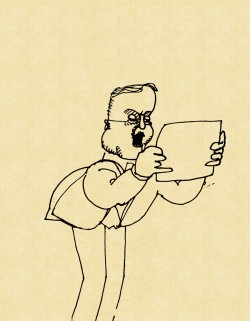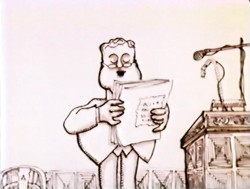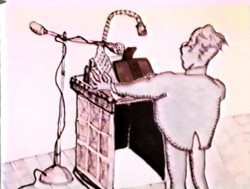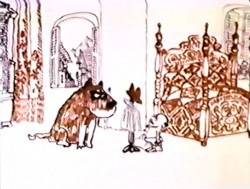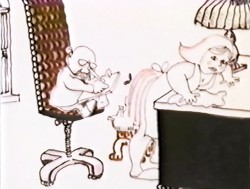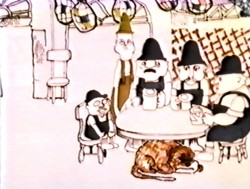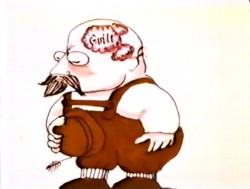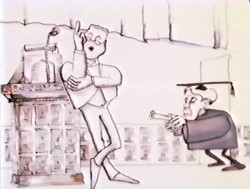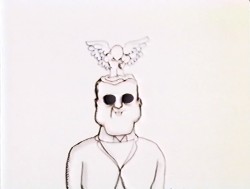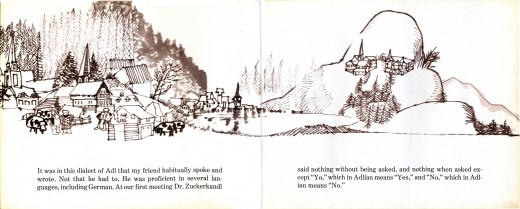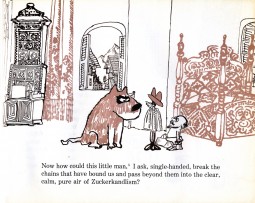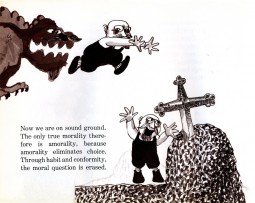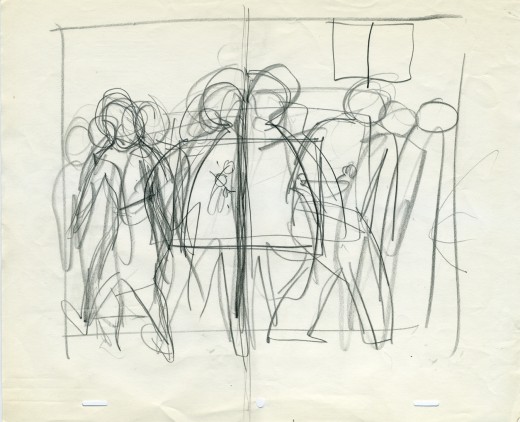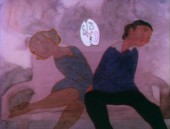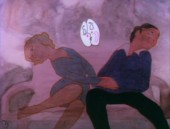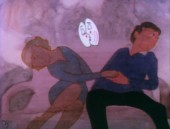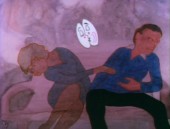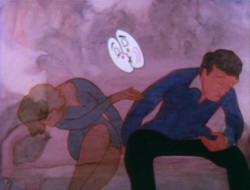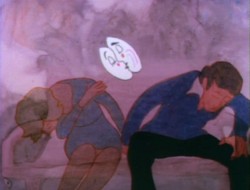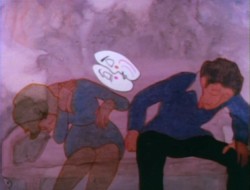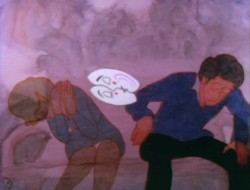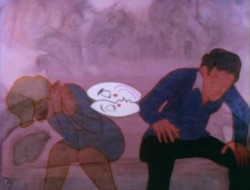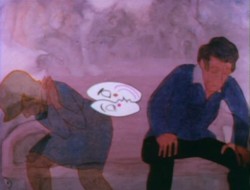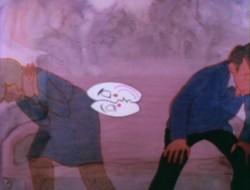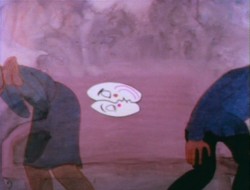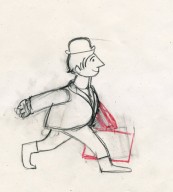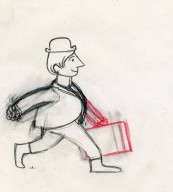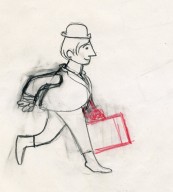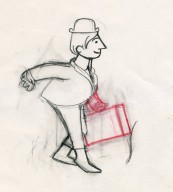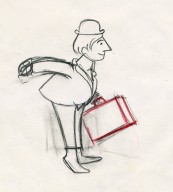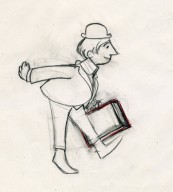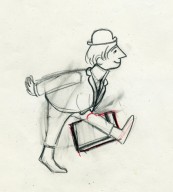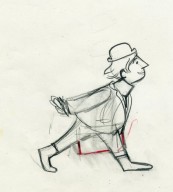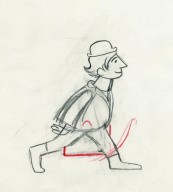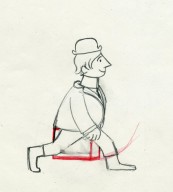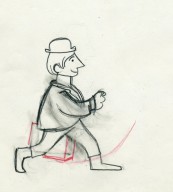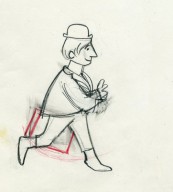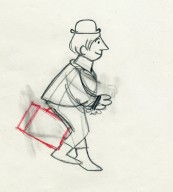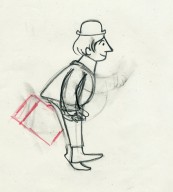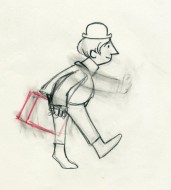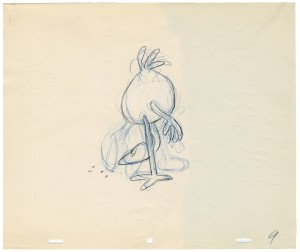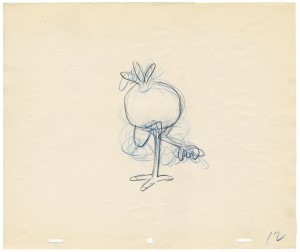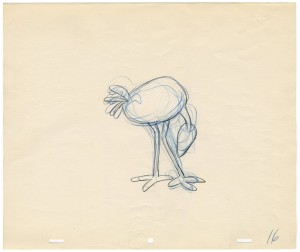Category ArchiveHubley
Animation Artifacts &Hubley &Story & Storyboards 30 Jul 2007 08:06 am
Cockaboody Board 1
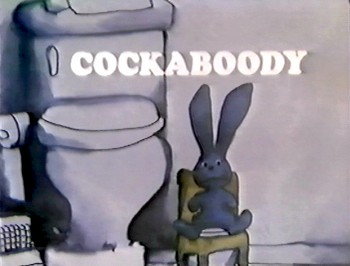 – I have a photostat copy of the storyboard to John and Faith Hubley‘s short film, Cockaboody. So I thought I’d post it to give a good demo of a storyboard from a master. The board was done in 1973.
– I have a photostat copy of the storyboard to John and Faith Hubley‘s short film, Cockaboody. So I thought I’d post it to give a good demo of a storyboard from a master. The board was done in 1973.
I had worked at Hubley’s for four months on Letterman and was layed off when that work ran out. They started preliminary work on Cockaboody while I was working on the feature Tubby The Tuba.
I left that project in time to get back to see the final scenes of Cockaboody colored, and I did a little animation of a rocking chair, with the two girls cradling it, at the film’s end. I didn’t do enough work on the film to receive credit, but I can still see my pencil lines on those two girls at the end of the film.
The film tells the story of two girls playing in a room next door to their babysitter. They laugh they cry they laugh they cry.
The film was improvised by Emily and Georgia Hubley in a recording studio years before they started the film. From the edited tracks a story was culled, and a storyboard formed. John did all of the drawings in storyboarding it.
Here are the first six pages; there are 17 in all. I’ve inserted fraame grabs so you can see how the final turned out. Tissa David animated the entire film.
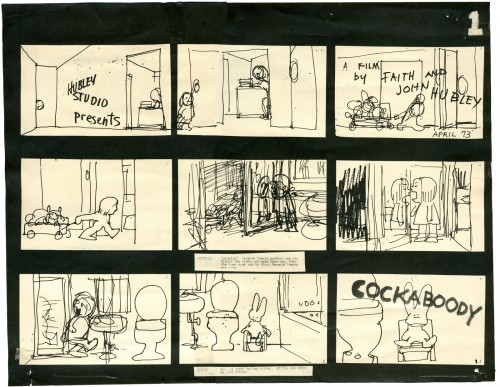
___(Click any image to enlarge.)
____________________________________________________(to be continued.)
Animation Artifacts &Hubley &Tissa David 24 May 2007 08:20 am
More Demons
- Last Monday, May 21st, was John Hubley‘s birthday, so it seems appropriate to focus on one of his excellent films. Continuing yesterday’s posting of Tissa David artwork from Of Men and Demons, I have more of the layouts she did for this opening sequence of the film. As I mentioned, Art Babbitt did the opening scenes and Tissa then was hired to revise these scenes and go on from there.
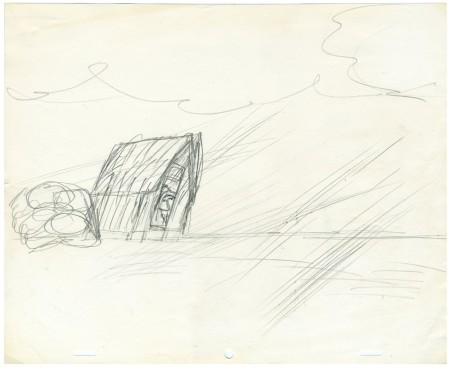
This is the BG Layout for the first scene with the farmer.
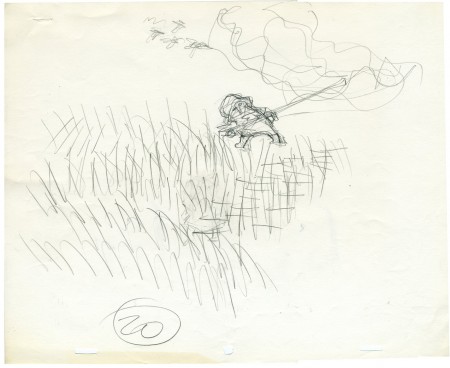
These character positions go with the opening scenes that Art Babbitt animated
and Tissa revised. These are Tissa’s drawings.
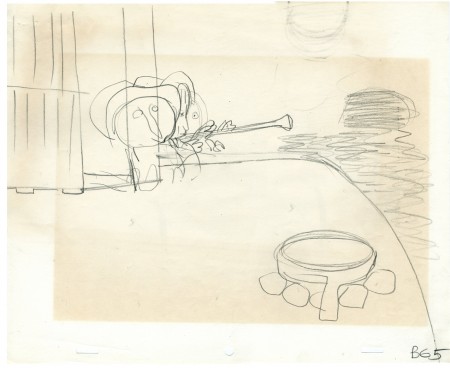
This is the BG Layout for the scenes Tissa started animating.
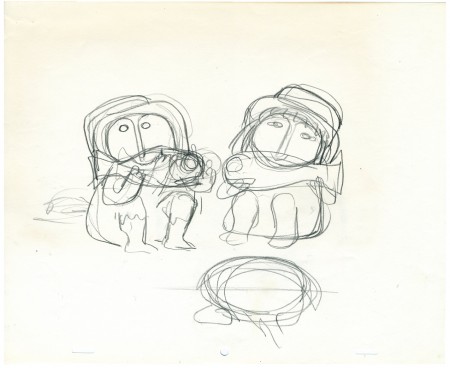
These two rough drawings indicate overall poses for the scene wherein
the two characters begin sharing their lives.
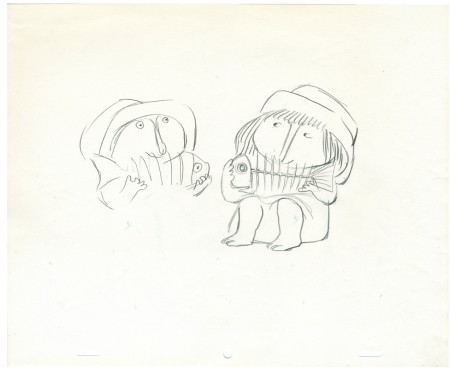
The drawing above and the following drawings represent the poses
Tissa prepared for her animation of the scene.
Finally, here are frame grabs from the scene
so you can see how it all came together:
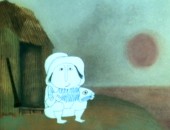
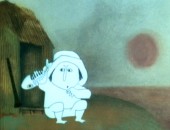
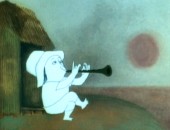
Animation Artifacts &Hubley &Tissa David 23 May 2007 08:05 am
Of Men & Demons
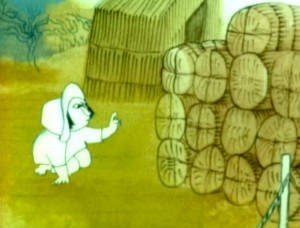 – Since first seeing the Hubley short, Of Men & Demons, back in 1967, I’ve been a fan. The artwork was stunningly different and original. It had a rich tone to it and some beautiful artwork. The music by Quincy Jones was as original as the film, itself.
– Since first seeing the Hubley short, Of Men & Demons, back in 1967, I’ve been a fan. The artwork was stunningly different and original. It had a rich tone to it and some beautiful artwork. The music by Quincy Jones was as original as the film, itself.
The short was actually an industrial film done for IBM to explain the binary code to its employees. The Hubleys, however, built on that story to make something of a personal film that received an Oscar nomination.
(Click any image on the page to enlarge.)
Art Babbitt was one of the first animators hired. At some point, Tissa David was brought on to rework some of Babbitt’s beautiful animation. Unfortunately, it was on about a fourteen levels and had to be combined and reconstructed and shortened. (Today, of course, there are no limits to levels, but in the days of the camera you kept things to 4 cel levels, as a rule, and never more than 5.) It was complicated by the fact that John Hubley had decised to shorten the piece, and Quincy Jones’ score was shorter than Babbitt’s animation. This chore took some effort and involved dissolve animation. Tissa then continued on the sequence animating the little protaganist and his female companion through the remainder of the film.
About 25 years ago, Tissa David gave me an envelope full of art from this film, and going through a lot of my old material recently, I came upon that envelope. I’m going to post a few of these drawings in the next day or two.
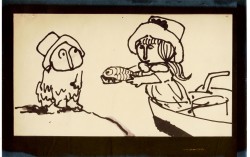 3
3 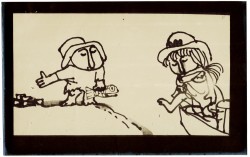 4
4
These are storyboard drawings for a short sequence. Tissa got these drawings and prepared LayOuts for the sequence. You can see how much is actually in John’s drawings so it’s easy to build on what he’s given you.
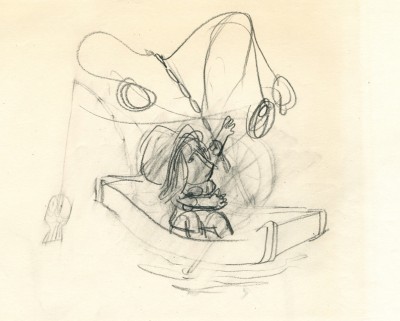 1
1The following are key drawings Tissa prepared for the sequence in laying it out.
Animation Artifacts &Hubley &Story & Storyboards 28 Feb 2007 08:04 am
Hub Boards
- The conversation on storyboard use goes way back – before the internet. If you check out the 1969 book by John Halas, Techniques of Film Animation, there’s a Q&A session wherein a number of animation greats were asked several questions, and the answers are given by question.
Here’s one question about storyboards and the answers given:
To what extent to you think a storyboard should be developed prior to production?
- GENE DEITCH: I believe in complete scene and shot breakdown in story-board or a thumbnail board form before production begins. I use a thumbnail storyboard as a sort of bar-sheet, indicating all effects, dialogue and music cues, scene transitions, etc. Great savings in cost, and an overall perspective of the film in advance are to be gained.
JOY BATCHELOR : As fully as possible without detriment to the following phases of production.
STEHPEN BOSUSTOW: If time and money allow, the storyboard should include as many details as possible, particularly if it is to be assigned to a large production unit. However, if only a few people are to be working on the picture, the storyboard can be quite sketchy, with the details being developed during production by the key people who have an overall feeling for and knowledge of the story.
ADRIAN WOOLERY: The storyboard is the first step, after the idea. Every problem must be solved and the story completely resolved on the board prior to consideration of any production.
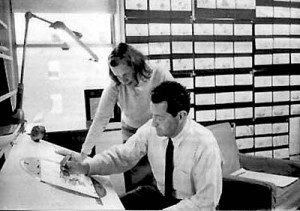 JOHN HUBLEY: It has been my experience that the more detailed a story-board and the more carefully it is designed to reflect the appearance of the finished production, the more successful the film.
JOHN HUBLEY: It has been my experience that the more detailed a story-board and the more carefully it is designed to reflect the appearance of the finished production, the more successful the film.GEOFFREY SUMNER: The storyboard, or breakdown of the film, has as many different forms as there are ways of putting actions in relation to one another.
The classic storyboard is the set of working drawings of the sequence of a film used in large studios on the Disney model where numbers of subsidiary workers must conform to a total pattern they can almost never see.
It is used in conjunction with model sheets. It could be called the “model sheet” of the sequence of the film.
It is strictly for use within a studio and should not be shown to dangerous people like sponsors.
An earlier stage is the treatment, which can be specifically directed at sponsors. If the basic idea of the film is simple, the treatment need be no more than half a dozen drawings and a brief synopsis to convey a ten minute film.
A storyboard must necessarily be constructed after the music has been done. The musician and the director can work together from a stage following the treatment. From the finished recorded track the storyboard is made.
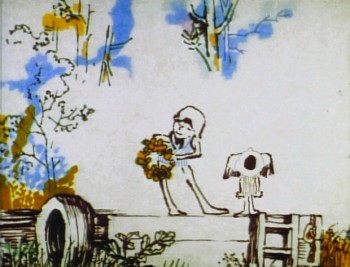 For years prior to even meeting Hubley, I had remembered his response to this question. It impressed me. His storyboard development was pretty intense. The scripts generally were done visually and tacked to the wall.
For years prior to even meeting Hubley, I had remembered his response to this question. It impressed me. His storyboard development was pretty intense. The scripts generally were done visually and tacked to the wall.
I don’t remember ever seeing text up there. John would present the board to key people, and he would give an indication of dialogue verbally. We all knew this would ultimately be ad-libbed by actors.
With the Carousel feature, sections were boarded but then developed in greater  length through improvised sessions. The boards then grew out of the edited tracks. The voices often came first, here.
length through improvised sessions. The boards then grew out of the edited tracks. The voices often came first, here.
I suspect this is probably also true of the films like Cockaboody, Windy Day and Moonbird which were dependent on the children’s verbal play at the microphone. Something like The Hole or Voyage To Next were boarded visually, then recorded improv sessions which were adapted in newer boards.
Of course it has to be remembered that the two features done within this studio, Everybody Rides The Carousel and Of Stars and Men, both started out as text. Both were heavy-duty books that were adapted for film. In the case of Of Stars and Men, the author, mathematician Harlow Shapely had major involvement in the film’s script and narrated it as well. The concepts for both films were fully worked out before anyone started boarding. So essentially a script – of sorts – existed. Since CBS financed Everybody Rides The Carousel, you know they had to approve a script.
I, of course, only remember the board.
Animation Artifacts &Hubley 10 Feb 2007 08:44 am
Watership Down Down Down
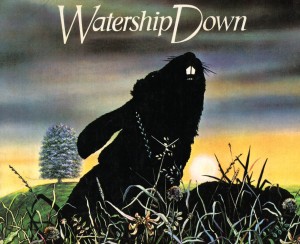 – Yesterday, Mike Barrier expressed some angerl on his site regarding sloppy animation history. He takes to task Stephen Worth and a couple of others.
– Yesterday, Mike Barrier expressed some angerl on his site regarding sloppy animation history. He takes to task Stephen Worth and a couple of others.
I couldn’t agree more with him regarding bad history on the internet. Errors appear everywhere, not just the internet but on these classic dvd’s we buy. (e.g: There’s conflicting information on #3 of the Looney Tunes set’s comment-ary tracks. It’s annoying. Since I particularly trust Barrier‘s accuracy, I went with his version.)
(Click any image to enlarge.)
I give you this information by way of introduction to some probably poor history I’ll present. Everything I offer is guess work. Unlike some others who are overconfident about their guess work, I’m emploring anyone who has conflicting information to let me know so that I can straighten the record and learn the truth, but I do feel somewhat confident.
The subject is John Hubley‘s involvment on the feature Watership Down.
I made some comments a couple of days back about Doonesbury and it prompted a question by David Nethery which started my rambling in response. I decided to add a couple of illustrations, and it’s evolved into this post.
There is no doubt in my mind that Hubley planned and shaped the opening sequence built around aboriginal art. Australian production designer, Luciana Arrighi often gets credit for this. However, I am sure Hubley put it into action and directed it. It’s his style. Perhaps it’s his style by way of Luciana Arrighi, but in the end it came out Hubley‘s.
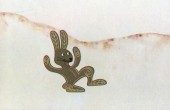
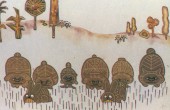
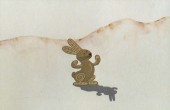
Also obviously his is the guiding spirit of the Black Rabbit of Inle which appears throughout the film particularly after the death of Hazel.
Bill Littlejohn, Phil Duncan, Ruth Kissane, and Barrie Nelson – all Hubley regulars – acted as animator or animation directors on the film. I think they visited the studio in England, but most certainly worked freelance from their homes. A guess – strictly a guess – is that Phil Duncan animated that opening. It feels like his work to me.
I was not in touch with John during this feature or after he had been pushed out of it. At the end of Everybody Rides The Carousel I moved over to Raggedy Ann. Dick Williams had been a hero of mine since the late sixties when I learned of his work. I’d had a number of letters back and forth to his Soho studio, and I contemplated the trip to show him my art. (How much easier everything is with the internet!)
As Carousel wound down, I watched closely as Dick competed for the Raggedy feature. He worked with Tissa David to do a short pencil test of Ann & Andy dancing to a piano score by Joe Raposo. Shamus Culhane was doing the same for Joe Oriolo. The two presentations went solidly Dick’s way, and he got that film. Tissa presented my name to Dick, and I was offered the first staff position on the upcoming feature.
At the same time, John Hubley was offered Watership Down. He had made the comment that he’d like to do the job that Halas & Batchelor had blown with Animal Farm, and he thought this could be the film fo that. This was a very exciting prospect to my ears. However John didn’t want me to go to England. I sure would have followed if he’d asked.
He asked if I would stay in New York and manage his studio there. He thought it might be possible to do some work in New York while he did the film in London. We even negotiated a very meager salary (John was the tightest guy I knew. He’d faced bankruptcy several times and watched his money closely.) Ultimately, watching what was about to happen half a mile away was too enticing for me. I wanted the chance to work with Dick Williams who had already brought on board Art Babbitt, Emery Hawkins, John Kimball, Gerry Chiniquy, Corny Cole and others. My allegiance was more with Tissa by this point, and I made my decision.
So, my analysis of the scenes I see is based solely on my love of Hubley’s work. I’ve inbetweened and inked and colored thousands of Phil Duncan’s drawings and scenes, and I’ve designed for John Hubley knowing full well that every drawing I was to do under him came out looking like a Hubley film. (John was the best artist I’ve ever met, so no one, in my opinion, could match what he could do with the simplest of lines.) I think my speculation on these short scenes in Watership Down is correct. I hope anyone won’t prove me wrong, but there it is.
There’s a very nice piece on the web by Richard Bell about his work in BG’s under Hubley and Martin Rosen.
There’s also an extensive and very insightful piece by Chris Boyce with analyzes the film in depth. He tries hard to separate what might be Hubley’s from Rosen’s.
Daily post &Hubley &Tissa David 07 Feb 2007 08:16 am
Doonesbury
- The 1977 Hubley film of Gary Trudeau‘s Doonesbury Special has just shown up on YouTube. It comes in five parts. This is the film that was the last started by John Hubley.
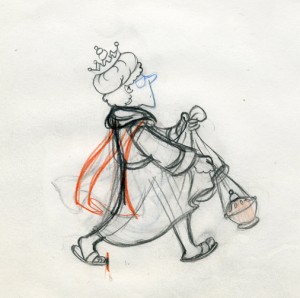 The Hubley Studio was an apartment on the Upper East Side of Manhattan. It was always crowded with beautiful, framed art: paintings by John and Faith, Backgrounds from their films, and the more attractive awards given to them.
The Hubley Studio was an apartment on the Upper East Side of Manhattan. It was always crowded with beautiful, framed art: paintings by John and Faith, Backgrounds from their films, and the more attractive awards given to them.
Stepping into the apartment/studio was like stepping into an art gallery brimming with modern art. I always felt like I should be whispering.
Fresh off Raggedy Ann & Andy, I was brought on board the show to assist John. I had missed the prior 18 months while John was in London working on and getting over the Watership Down debacle. ***
(One of Tissa’s 24 drawing walk cycle. Someday I’ll
post them all with rougher preliminary sketches.)
Returning to the studio was both a joy and a shock. All that great art, had Doonesbury strips ripped out of the newspapers and taped over all the framed Hubley art. I found it embarrassing given how great the art was underneath those strips.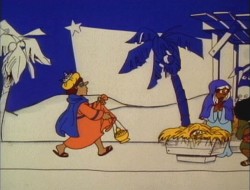
The show was just barely getting started. Actors had just started recording. John, Faith and Gary spent many of their days at the studio recording while I started development of the film’s art from the storyboards.
Kate Wodell, one of Hubley’s talented ex-students from Yale who had worked through Everybody Rides the Carousel, was the only other person on staff; I think she started a few days after me.
(Click any image to enlarge.)
Gary and I didn’t really speak more than to say hello, but it was obvious that he and I didn’t really get along. John strongly held onto me, and wouldn’t alow me to leave or be left.
However, about a month into the work, he called me to his room. John told me that he had to lay me off for a couple of weeks. He was about to go into the hospital for an operation up at Yale, and would halt work until his return.
John Hubley didn’t return. He died on the operating table.
After a short period, Faith announced that they would finish the film in John’s honor, and she and Gary Trudeau would direct in tandem. I decided not to return. I took a job assisting R.O.Blechman direct his first one-hour special, Simple Gifts.
About a month into my work, I got a call from Tissa David. She was animating the class play in the Doonesbury Special, and she needed help. She couldn’t find an assistant who could keep up with her on the schedule she had to meet for them. About 100 feet a week of pretty full animation.
I agreed to work free lance on Tissa’s work for Faith. During the day I was an Asst. Director on one PBS Special; at night I was an Asst. Animator on another CBS Special. When I completed Tissa’s scenes – about a month’s work – I got a call from Kate Wodell. Ruth Kissane had animated a piano rotating 90 degrees with a character playing the piano on another level, but she’d left many of the drawings for an assistant. No one at the Hubley studio could do it, and they asked if I would help out. I did the scene which took about a week.
Unfortunately, that was the last time I worked for Faith, even though we remained close up to her death.
(This is Ruth Kissane‘s sequence. I have the original drawings somewhere and
I’ll eventually post them.)
*** (I’m sorry this was not written clearly. I do not think Watership Down, the film, was a debacle. John Hubley’s involvment with the film and his treatment by Producer, Martin Rosen, was. See my comment below.)
Hubley &Models 24 Nov 2006 08:27 am
Zuckerkandl Models
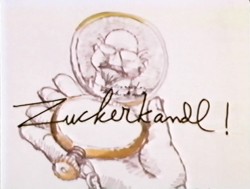 - One of my favorite Hubley shorts is a lesser known film, Zuckerkandl.
- One of my favorite Hubley shorts is a lesser known film, Zuckerkandl.
It is an animated version of the satirical lecture Robert M. Hutchins gives annually to discuss the life and philosophy of the fictitious Dr. Alexander Zuckerkandl and his philosophy that the goal of life is to get through it without feeling, in the belief that true happiness can be achieved only by becoming unconscious of our conscious.
The life and philosophy of Zuckerkandl is depicted and constructed.
I also have a couple of models of the speaker, Hutchins, done by John Hubley and I’m posting them here.
The following are frame grabs (from not the best copy of the film.)
The film was also made into a book. It’s illustrated with images from the film that have been reshaped. Here are a couple of them. The colors in the book are probably closer to the actual film.
Animation Artifacts &Hubley &Tissa David 04 Nov 2006 09:10 am
Carousel LO
- One of my favorite experiences in my animation career was working on the Hubley film Everybody Rides The Carousel. This was a feature done for CBS. It was adapted from the work Childhood and Society by the noted psychologist, Erik Erikson‘s. His book was a treatise on the development of humans; he broke the stages of man down to eight.
In Hubley’s film, each stage was represented by a horse on the Carousel.
At the sixth stage, my favorite part of the film, two young adults find each other, fall in love, separate and come back together. The female Voice/Over was done by a Yale student in her first film role, Meryl Streep.
Here’s a layout by John Hubley, given to Tissa David for a seminal scene in the film. The boy and girl have fallen in love and present themselves to each other wearing symbolic masks; they cannot reveal their true feelings to each other. The masks, which don’t come off, cause them to grow apart and separate.
In this one rough drawing, John expressed volumes, and Tissa animated what is, to me, possibly the best scene in the film.
To show how it ended up, I’ve taken some key frame grabs from the actual film. The scene actually plays out slowly, and acts as a coda at the height of the sequence.
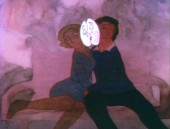 1
1 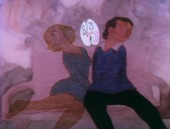 2
2
(Click any image to enlarge.)
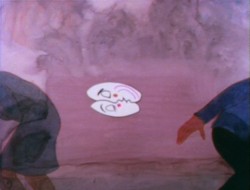 The artwork was colored on layers of vellum designed for architects. It came in rolls and had to be cut and punched. Little of the paper’s grain showed when it was bottom lit. The drawings were inked and colored with magic markers: water based ink lines and alcohol based fill colors. (This prevented the ink lines from smearing.)
The artwork was colored on layers of vellum designed for architects. It came in rolls and had to be cut and punched. Little of the paper’s grain showed when it was bottom lit. The drawings were inked and colored with magic markers: water based ink lines and alcohol based fill colors. (This prevented the ink lines from smearing.)
It was photographed from below – like a pencil test. To soften the background a blank layer of the vellum was used between the background and the characters. The masks were doubled into the scene after it was shot. They were filmed top-lit at 80% exposure.
This was the technique for this one sequence in the feature. Most of the rest of the show was shot traditionally, top lit. Each stage had its own technique and color scheme.
Animation Artifacts &Hubley &Tissa David &walk cycle 10 Oct 2006 07:55 am
Upkeep Cycles
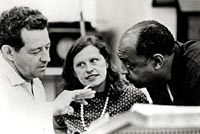 – Back in 1973, the Hubleys produced Upkeep, a short film for IBM. It chronicled the history of the service repairman in a light hearted way. Actually an industrial, it was treated like a personal film. (There’s a thin line between some of their industrials and their personal films.) Of Men and Demons was done for IBM though they considered it a personal film; it instructed in the positive aspects of the binary code and was nominated for an Oscar.
– Back in 1973, the Hubleys produced Upkeep, a short film for IBM. It chronicled the history of the service repairman in a light hearted way. Actually an industrial, it was treated like a personal film. (There’s a thin line between some of their industrials and their personal films.) Of Men and Demons was done for IBM though they considered it a personal film; it instructed in the positive aspects of the binary code and was nominated for an Oscar.
(John & Faith Hubley with
composer, Benny Carter)
Tissa David did the lion’s share of the animation for Upkeep. Phil Duncan, Lu Guarnier and Jack Schnerk were the other key animators on it. Helen Komar and I assisted all of them, and I inked the whole film. Gen Hirsch and I colored it. John did all the Bg’s.
The initial animation on the service man was done by Phil Duncan. Tissa had to pick up the character, and she found the walk Phil had done so funny that she kept it throughout the film adding shades and tones to it as she thought appropriate.
The art was inked with a sharpie, bled with thinner, then colored with magic markers. Each drawing was then cut out and pasted to cels. Hubley’s Bg’s followed the same style: sharpie on board, washed & bled with thinner, added watercolor washes.
Posted below are the drawings for that 18 drawing walk cycle.
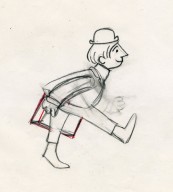
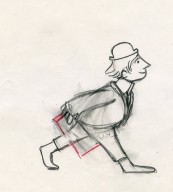
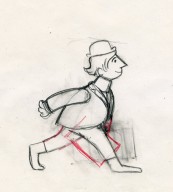
(Click any image to enlarge them.)
Animation Artifacts &Hubley 14 Sep 2006 08:00 am
Moonbird
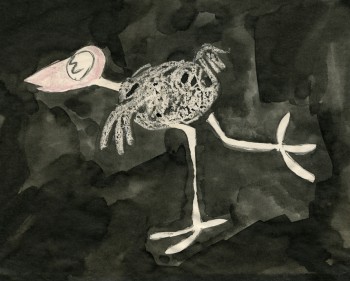 – Moonbird is one of the seminal films of 20th Century animation.
– Moonbird is one of the seminal films of 20th Century animation.
After John Hubley left UPA, where he helped explore the use of 20th Century graphics in animation, he formed a commercial animation company in Los Angeles. Apparently, with this new entity, John did less drawing and more producing. Trying to correct this problem, he closed the LA office and set up in NYC with Faith.
The studio in New York did commercials on a smaller scale. With a Guggenheim Fellowship of $8000, the couple produced a short film, Adventures of an * in 1957 and committed to doing one film a year for themselves. With this film, Hubley picked up where he’d left off at UPA. Exploration of modern art now took on the wildly successful Abstract Expressionists and told a non-verbal story using expressionist art.
The film Tender Game, done in 1958, told another non-verbal story using the song “Tenderly” to illustrate a romance, again, in expressionist art. This film, in some ways, feels like an outgrowth of Hubley’s work on the feature, Finian’s Rainbow.
In 1959, Moonbird took a giant leap forward. The art style borrowed from the expressionists, but used a method of double exposures to layer the characters into the backgrounds. Each animation drawing was painted black outside the border of its lines. Moonbird, the character, was colored with clear wax crayon and painted with black ink. The black resisted where the wax stood and gave a loose scribbled coloring. All of these painted drawings were photographed as double exposures, shot at less than 100%, to combine characters with Bgs.
The soundtrack involved an improvised track of two children, Mark and Ray Hubley, playing. These were recorded in sessions within a recording studio and massively edited down to create the final tracks.
Bobe Cannon animated the film with Ed Smith assisting. Ed inbetweened Bobe’s scenes and animated many others.
A variation of this became the Hubley method. There was usually someone working in the studio who did all inbetweens and animated some lesser scenes. A great way to break into the medium in a big way.
Some extremes by Bobe Cannon are posted below.
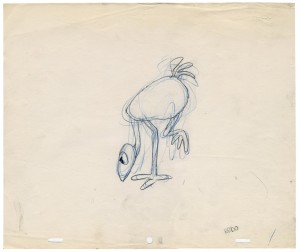
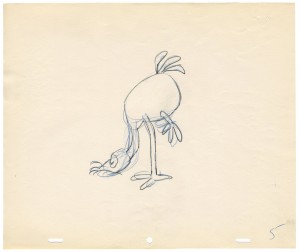
(Click on any image to enlarge.)
Amid Amidi has posted a link to a YouTube version of the film. It looks good.
